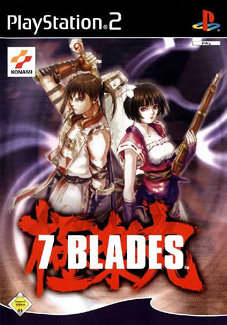Top Qs
Timeline
Chat
Perspective
7 Blades
2000 video game From Wikipedia, the free encyclopedia
Remove ads
7 Blades (セブンブレイズ) is an action-adventure video game developed by Konami for the PlayStation 2 (PS2) home game console. It was released in Japan on December 21, 2000 and in PAL regions on September 28, 2001.
Remove ads
Plot
7 Blades is based on the 1990 film Zipang, directed by Japanese filmmaker Kaizo Hayashi.[1] The game takes place in mid-17th century Japan, during which the Tokugawa shogunate was gaining power. The game is set on the man-made island Dejima, which the Japanese government is using to house Western foreigners and where a Christian group is trying to separate from the rest of the country.[1][2] The main character is Gokurakumaru, a violent mercenary and poor womanizer. He travels with his gun-wielding love interest (Oyuri) and sidekick (Togizo). The latter provides comic relief and holds the swords as Gokurakumaru collects them one by one.
Remove ads
Development and release
Summarize
Perspective
7 Blades was developed by Konami Computer Entertainment Japan East (KCEJ East) in association with Paradise Pictures. The game was in development for over two years with a staff of around 20 people. Konami was assisted by Hayashi, who served as the game's directing supervisor and was given creative control over its storyline, dialogue, and action.[1][2][3] Hayashi had not been involved in video games prior to 7 Blades, but began leaning towards production of such a game when visual advances in computer graphics were made in the medium, striving to make it "universally appealing".[3] Hayashi wanted 7 Blades to cover a wide range of genres, and even with the player killing a large number of enemies, he hoped that it could also be enjoyed as a sophisticated sword-fighting game. Hayashi felt that meshing the story branches of the two playable characters was a feature "only possible in a game".[3] Hayashi chose to create a game rather than a film due to what he perceived as the limitless potential of games.[4]
Both Hayashi and producer Atsushi Horigami understood the importance of gameplay and insisted on making "a movie with some very deep action gameplay elements".[1] Project director and writer Shinsuke Mukai described the game as similar to both Tomb Raider and Tenchu while leaning towards more action and less stealth-focused gameplay.[4] The game was initially planned for the original PlayStation.[5][6] However, the developer was only able to achieve three enemies alongside the player so more powerful technology was sought. The Dreamcast was a consideration, but the PlayStation 2's hardware allowed for superior backgrounds and up to 20 simultaneous enemies.[7]
7 Blades was announced by Konami in May 2000, just before the Electronic Entertainment Expo (E3).[8] Konami released the first screenshots of the game in July of that year and made it available to play at the Tokyo Game Show in September.[9][10] The game was released in Japan on December 21, 2000 alongside the 7 Blades Original Soundtrack produced by the Meyna Company and the single for the opening theme "Love Will See Us Though" by Sayaka Kubo.[11][12][13] A novelization of the game titled 7 Blades Jigoku Gokurakumaru to Teppou Oyuri (7BLADES—地獄極楽丸と鉄砲お百合) by Ryosuke Sakaki was published by Dengeki Media Works in February 2002.[14]
Remove ads
Reception
Reception
7 Blades was met with an indifferent critical response from European and Australian publications, currently holding an aggregate score of 64.5% on GameRankings.[15]
The game was re-released under the "Konami the Best" range of budget titles in Japan, as well as its collection of European budget titles.[20][21]
References
External links
Wikiwand - on
Seamless Wikipedia browsing. On steroids.
Remove ads

